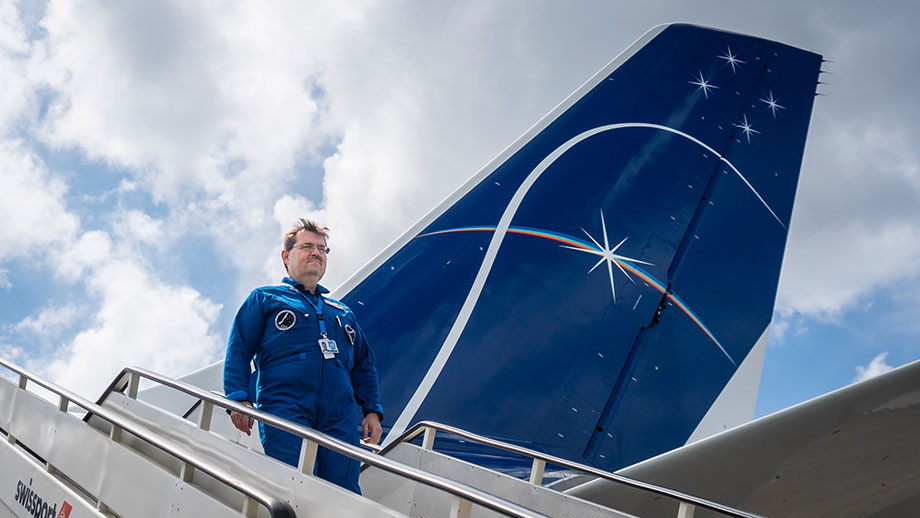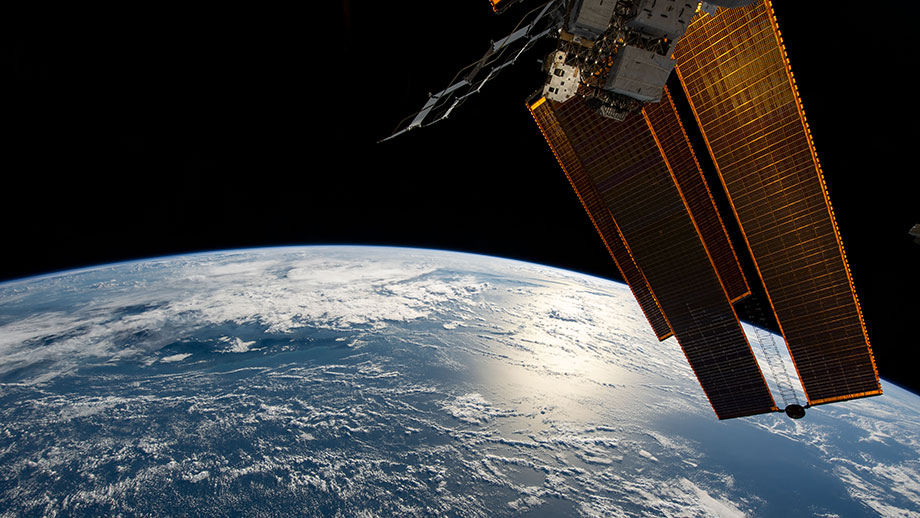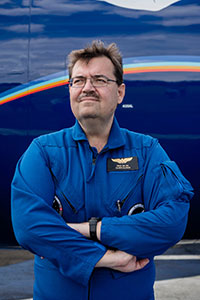A Factory in Outer Space

Oliver Ullrich, you’re the Director of the UZH Space Hub and conduct research in the field of space biotechnology. When did you first start dreaming of outer space?
Oliver Ullrich: I started becoming interested in space early on in my research career. I didn’t have a specific moment that turned me on to space, nor was it part of my boyhood dreams. Before coming to UZH, I was working on molecular immunology at the Otto-von-Guericke University Magdeburg. During that time, I came across an article in Science by Augusto Cogoli, a Swiss pioneer in space research. In 1983, he conducted a groundbreaking experiment with human lymphocytes on an early space shuttle expedition. He noticed that they no longer worked well in zero gravity. Here it was shown for the first time that gravity regulates the function and behavior of human cells, potentially on a fundamental level. Take gravity out of the equation, like in space, and the human cell no longer works as intended.
I found that interesting. So 18 years ago I started doing research using ground-based simulations and experiments on parabolic flights that can create conditions of zero gravity for a short period of time. Other experiments followed later, on suborbital research rockets and on the International Space Station (ISS), and there it also became clear that weightlessness impacts cells in a way that merits further research.
What was about this finding that caught your attention?
Ullrich: Usually you don’t think about gravity – it’s just always there. We live on Earth, and we often take for granted the things that simply surround us. However, the findings from zero gravity experiments showed that gravity is actually essential to our biology. The question of why that is – why a cell needs gravity to function properly – really captured my imagination.
Have you already found the answer?
Ullrich: We’ve found that the entire cell responds to weightlessness. In other words, the entire cell acts as a sensor, not any particular molecule or receptor. It mechanically transfers gravity to the nucleus, which changes the position of certain genes and leads to changes in gene regulation.
In 2014 we conducted a groundbreaking experiment on the ISS, where we were able to observe this reaction live in space for the first time. We found that the cell reacts to zero gravity within a matter of seconds. Within one minute, it was able to adapt to the new situation, which is much faster than we expected. We conducted additional experiments, where we were able to observe and study how several thousand genes reacted to conditions of weightlessness. We were able to pinpoint the genes that underwent changes. They were not randomly distributed throughout the genome but instead formed clusters. Gravity is encoded into the spatial structure of our genes. Just like the existence of a genetic code, there also exists a spatial code for reacting to gravity and zero gravity.
Why is this finding important?
Ullrich: First of all, this lets us understand the basic construction of the cell. I’m also an anatomist. For centuries, the field of anatomy has known that the human body is adapted to gravity. It has shaped our musculoskeletal system and our organs, all the way down to the cellular level. Understanding this is key to understanding life on Earth.
What practical lessons can be taken from this?
Ullrich: Once we know that zero gravity has a decisive effect on the behavior and function of cells, we can then use it as a tool. We did this recently. On two missions to the ISS, we were able to manufacture three-dimensional, organ-like tissues using human stem cells. These tissues only grow three-dimensionally in zero gravity. On Earth and in labs they require highly complicated auxiliary structures to do so. Thanks to our research, we now have a new instrument for creating new things in space that were previously not possible.
What can you do with this instrument, in concrete terms?
Ullrich: We have the possibility to produce functional, 3D tissues from adult stem cells in zero gravity. This currently works with liver, bone and cartilage. Human liver tissue in particular is valuable when it comes to developing drugs. Many medicines fail in clinical trials because they are toxic to the liver. If you’re able to identify liver toxicity at an earlier stage in the development process, you can do away with countless animal experiments and save a lot of time and money in the process. This is possible with 3D human tissue produced in space.
Does this mean that in the future, we’ll be growing livers and bones for transplantation in space?
Ullrich: That’s the holy grail – replacement tissues that can be grown outside of the body. The technology for this is super complicated, but it’s possible in principle. In the future, we can deliver the small pieces of tissue that were grown in space and later use them to produce a 3D organ with a bio-printer. This can happen back on Earth and perhaps even in outer space.
How realistic is this?
Ullrich: The approach is highly promising. We of course can’t yet predict how this translates to a clinical setting. But that’s always the case: research starts off with a lot of ideas but only a few of them make it to the finish line. But I see great potential here. Especially since the costs of getting to space are sinking dramatically. Additionally, there are going to be more carrier platforms in near-earth space in the future, meaning more opportunities for experiments and production. This is no longer far off in the future. They are already building these platforms in the US. Harnessing the potential of space has practical significance for humans in the sense that space can act as a factory for creating things that wouldn’t be possible on Earth.
There’s been a massive increase in the use of space. In addition to state-backed space travel programs, there are also private parties like US billionaire Elon Musk who are carrying out projects in space. What’s the significance of space today, both scientifically and commercially?

Ullrich: The commercialization of near-earth space has made it possible to conduct research projects that aren’t dependent on the big space exploration nations such as the US and Russia – and nowadays also China. NASA kicked this off around 10 years ago with its proposal of using the ISS for commercial purposes. In parallel, transport routes to the space station have also been commercialized. This enabled the birth of SpaceX, founded by US billionaire Elon Musk. This in turn enabled a veritable boom of technological development.
Without NASA’s initiative, we wouldn’t be as far as we are today. The ISS is the first outpost in space that has made it possible to develop commercial applications for use on Earth. And it’s also a place where all nations work together in peace. There’s nothing equivalent on Earth. The ISS is a good example of what can happen when all the big technologically advanced nations pursue a common goal. Great things can happen if humanity works together in outer space.
What could this mean for the future?
Ullrich: One of NASA’s goals is human exploration of Mars and – on the way there – establishing a permanently staffed space station on the Moon as well as a station in the Moon’s orbit called the Lunar Gateway. I think these goals are pretty much unachievable with the currently available budget. The resources required to develop the technology for interplanetary travel can’t be coughed up by one country alone. If we want to become an interplanetary species in the future, we’ll need to see to it that various nations are able to successfully cooperate in peace. This will require a critical mass of humanity to join in.
If that works, will we be able to settle on the Moon or Mars?
Ullrich: We wouldn’t settle on the Moon or Mars but rather set up research stations and outposts. These aren’t planets that are hospitable to life. We’ll be able to test things on the Moon and Mars that would be critical for further interplanetary exploration. An important issue in this context is autonomy, meaning the question of whether and to what extent we can live independently from the Earth. How can we learn, for example, how to survive with just a few non-renewable resources for a long stretch of time in a hostile environment? Researching habitats on the Moon and Mars could also be very relevant to understanding ecosystems on Earth.
What kind of lessons can we learn from this for life on Earth?
Ullrich: We have a lot of resources on Earth – our planet is wonderful. In the end, though, we live on a thin crust with little atmosphere surrounding us. Life is impossible both below and above us – and that extends all the way into the endless expanses of the universe. So we have to learn how to get by on this tiny sliver of a life-giving environment, an oasis which is embedded in the most hostile environment imaginable. We have to learn how humanity can live successfully, and as well as possible, with limited resources. So there’s a lot to be learned in outer space, where there’s either nothing or too little of what humans need to survive. Once you’ve managed to survive in an environment like that on a small scale, you can scale up the lessons learned for living on Earth.
What else can be learned from space?
Ullrich: In addition to biotechnology, there has been very interesting progress in terrestrial observation. The methods are getting more and more precise, the data more and more high definition. We’ll soon be able to determine the health of plants from space. Do the grain crops on a field have enough water and fertilizer, for example? In the future we’ll be able to collect data from near-earth orbit that will allow us to practice precision agriculture in a way that’s strategic, efficient and protects resources. And we can also explore the biodiversity of our planet. This is another research field where UZH is really at the head of the pack internationally. UZH is also a scientific leader in astrophysics. The supercomputing being used there is yielding extremely interesting insights.
Space exploration, also in the context of Earth observation, is connected to the UZH Space Hub, where you’re director – what are the strengths of this research network?
Ullrich: Our university has been a leader in space research for years. Now with the Space Hub, we’re well situated to grow our network of research and researchers, both internally and externally. UZH is strong in the fields of space research that are currently experiencing the most development: Earth observation, life sciences, astrophysics, supercomputing and autonomous navigation. We’re now working on bringing more disciplines closer together. That’s the nice thing about a full-spectrum university like UZH: the diversity offers a great opportunity for asking totally new questions and launching innovative projects.
On top of that, the UZH Space Hub also makes certain research possible by providing infrastructure, for instance as part of the Swiss SkyLab research flight program, which has been built up in Dübendorf over the past six years. The Space Hub also intensively promotes knowledge transfer by bringing research closer to startups, SMEs and the private sector.

You’re approaching the issue of space also from a theological perspective. You recently finished studying theology at the Pontifical Lateran University. Why are you interested in the field?
Ullrich: I’m interested in the question, for instance, of how to conceptualize humanity in an expanded context that includes space travel and the universe. Currently, space travel is shaped by technology. But the real question is – what exactly are we looking for on the Moon or on Mars? Do we have to go there at all? Do we need space travel? What purpose do humans have in space? Are we just earthlings, or do we have universal significance? Is space exploration part of our natural frame of impact? These are questions that go far beyond the empiricism of natural science research, but they can be explored using philosophical and theological methods. But these are questions about existence itself and about the meaning of life.
From this perspective, does it make sense to fly to the Moon or Mars?
Ullrich: That’s what we have to find out. I don’t mean this evasively – I’m entirely serious. Humans have always been on the move. It’s a deeply biblical concept. We’ve always been a mobile and curious species. Most of humanity’s new insights have come about from our mobility over the course of history, arising from exploring and being on the move. Humans will also gain new insights from space travel. One day we’ll learn how to understand our place in the universe.
What do you mean?
Ullrich: I’ll try to illustrate my point using a key question. We live here in the sphere of influence of a mid-sized star, our Sun. The Sun will keep shining for another 5 to 6 billion years. Over the next billion years, life on Earth, including humans, will be extinguished by the expansion of the sun. The Earth is around 4.5 billion years old, and the first life arose shortly thereafter. That means that four-fifths of the time for life on Earth is behind us. We’re at the end of the timeline. It could very well be that this is our fate and that there won’t be any continuation of the human species in space. But it could also be that in the distant future, humans develop the capabilities needed to leave Earth and go to other planets. Just like we came out of Africa in order to settle all over the globe. Our story remains open.
This article first appeared in the UZH Magazin, issue no. 3, 2022.